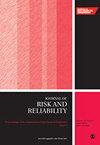A novel index for shearer system resilience in underground coal mines based on the operational environment
IF 1.8
4区 工程技术
Q3 ENGINEERING, INDUSTRIAL
Proceedings of the Institution of Mechanical Engineers Part O-Journal of Risk and Reliability
Pub Date : 2024-02-12
DOI:10.1177/1748006x231209810
引用次数: 0
Abstract
The use of resilience during the mining period by guaranteeing the safety and performance of the systems greatly helps the managers and engineers with their decision-making and designing different systems. During the last two decades, various studies have been conducted in this regard. However, the analysis of underground coal mining systems’ resilience has been rarely addressed by these studies. The present study aims to provide a quantitative index for resilience in the environment of underground coal mining operations based on the risk factors. To do so, in a case study of Tabas Mechanized Coal Mine, the Failure of shearer data and the stoppages caused by it (for 2 years and a half, from March 2017 to June 2019) were studied to analyze the system’s resilience. Then, the experts were surveyed. After collecting and categorizing the data, the data analysis calculations were done for indicators of reliability, maintainability, supportability, organizational resilience, PHM system efficiency, and economic resilience. Finally, a new quantitative index named the “Shearer System Resilience Index” was introduced. The results indicated that resilience is reduced over time. They also shows that in order to improve resilience, project managers should pay more attention to these indicators, especially the indicators of maintainability, and organizational resilience. Therefore, regarding the scope of the data investigated in the current study, the use of Failure of Shearer data-based risk factors and experts’ opinions for the analysis of resilience in the case study is strongly recommended.基于作业环境的煤矿井下采煤机系统弹性新指标
通过保证系统的安全和性能,在采矿期间使用复原力大大有助于管理人员和工程师做出决策和设计不同的系统。在过去的二十年里,人们在这方面进行了各种研究。然而,这些研究很少涉及地下采煤系统的复原力分析。本研究旨在根据风险因素,为地下采煤作业环境中的复原力提供一个量化指标。为此,在塔巴斯机械化煤矿的案例研究中,研究了剪板机故障数据及其导致的停机(2017 年 3 月至 2019 年 6 月,为期两年半),以分析系统的弹性。然后,对专家进行了调查。在对数据进行收集和分类后,对可靠性、可维护性、可支持性、组织复原力、PHM 系统效率和经济复原力等指标进行了数据分析计算。最后,引入了一个新的量化指标,命名为 "Shearer 系统复原力指数"。结果表明,复原力会随着时间的推移而降低。结果还表明,为了提高复原力,项目经理应更加重视这些指标,尤其是可维护性指标和组织复原力指标。因此,就本研究调查的数据范围而言,强烈建议在案例研究中使用基于数据的 Failure of Shearer 风险因素和专家意见来分析复原力。
本文章由计算机程序翻译,如有差异,请以英文原文为准。
求助全文
约1分钟内获得全文
求助全文
来源期刊

Proceedings of the Institution of Mechanical Engineers Part O-Journal of Risk and Reliability
ENGINEERING, MULTIDISCIPLINARY-ENGINEERING, INDUSTRIAL
CiteScore
4.50
自引率
19.00%
发文量
81
审稿时长
6-12 weeks
期刊介绍:
The Journal of Risk and Reliability is for researchers and practitioners who are involved in the field of risk analysis and reliability engineering. The remit of the Journal covers concepts, theories, principles, approaches, methods and models for the proper understanding, assessment, characterisation and management of the risk and reliability of engineering systems. The journal welcomes papers which are based on mathematical and probabilistic analysis, simulation and/or optimisation, as well as works highlighting conceptual and managerial issues. Papers that provide perspectives on current practices and methods, and how to improve these, are also welcome
 求助内容:
求助内容: 应助结果提醒方式:
应助结果提醒方式:


